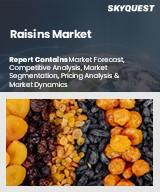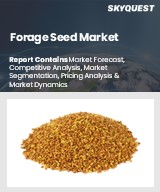
|
시장보고서
상품코드
1800296
씨 없는 포도 시장 : 예측(2025-2030년)Seedless Grapes Market - Forecasts fom 2025 to 2030 |
||||||
씨 없는 포도 시장은 2025년 730억 1,100만 달러에서 2030년에는 969억 8,300만 달러에 달할 전망이며, CAGR 5.84%로 성장할 것으로 예측됩니다.
씨 없는 포도 시장은 편리하고 고품질의 과일에 대한 소비자 수요 증가와 무종 품종의 품종 개량 진보로 강력한 성장을 이루고 있습니다. 신선한 과일과 건포도로 직접 소비되고 식품 가공에 적합하기 때문에 특이한 씨 없는 포도는 세계적으로 인기를 끌고 있습니다. 건강 지향 증가, 혁신적인 육종 프로그램, 북미 및 기타 중동 및 아프리카의 용도 확대가 시장을 뒷받침하고 있습니다. 생산 비용과 기후 변화와 같은 문제는 여전히 남아 있지만 연구 개발(R&D)의 지속적인 노력으로 품종 개발 및 시장 잠재력이 높아지고 있습니다.
시장 성장 촉진요인
주요 촉진요인은 간식과 요리를 위한 편의성 및 음식 경험을 향상시키는 씨 없는 포도에 대한 소비자 기호 증가입니다. 이 수요는 더 건강한 라이프 스타일로 세계의 변화에 의해 증폭되고, 씨 없는 포도와 같은 신선한 과일의 소비가 증가하고 있습니다. 육종 프로그램은 소비자의 취향과 상업적 요구에 모두 대응하기 위해 풍미, 식감, 탄력성을 향상시킨 무종 신품종을 개발함으로써 대응해 왔습니다. 이러한 품종은 씨의 흔적을 최소화하고 안정적인 품질을 제공함으로써 시장 호소를 높입니다. 또한, 건포도와 잼과 같은 제품의 생산을 간소화하는 씨 없는 포도에 대한 식품 가공 산업의 요구가 수요를 더욱 밀어 올리고 있습니다. 비공개회사는 연구개발에 많은 투자를 하고, 높은 수율과 독특한 풍미 등 경쟁 우위성을 제공하는 독자적인 품종을 도입하여 생산자의 수익성을 높이고 있습니다.
목차
제1장 주요 요약
제2장 시장 현황
- 시장 개요
- 시장 정의
- 조사 범위
- 시장 세분화
제3장 비즈니스 상황
- 시장 성장 촉진요인
- 시장 성장 억제요인
- 시장 기회
- Porter's Five Forces 분석
- 산업 밸류체인 분석
- 시책 및 규제
- 전략적 제안
제4장 기술 전망
제5장 씨 없는 포도 시장 : 유형별
- 서문
- 그린
- 레드
- 블랙
- 기타
제6장 씨 없는 포도 시장 : 유통 채널별
- 서문
- 온라인
- 오프라인
제7장 씨 없는 포도 시장 : 용도별
- 서문
- 신선소비
- 건포도 생산
- 주스, 와인 및 농축액 제조
- 식품 가공
제8장 씨 없는 포도 시장 : 지역별
- 서문
- 북미
- 용도별
- 국가별
- 미국
- 캐나다
- 멕시코
- 남미
- 용도별
- 국가별
- 브라질
- 아르헨티나
- 기타
- 유럽
- 용도별
- 국가별
- 영국
- 독일
- 프랑스
- 스페인
- 기타
- 중동 및 아프리카
- 용도별
- 국가별
- 사우디아라비아
- 아랍에미리트(UAE)
- 기타
- 아시아태평양
- 용도별
- 국가별
- 중국
- 일본
- 인도
- 한국
- 대만
- 기타
제9장 경쟁 환경 및 분석
- 주요 기업 및 전략 분석
- 시장 점유율 분석
- 합병, 인수, 합의 및 콜라보레이션
- 경쟁 대시보드
제10장 기업 프로파일
- Sun World International, LLC
- SNFL Group
- Grapa Varieties Ltd.
- IFG-International Fruit Genetics
- Camposol SA
- Anthony Vineyards, Inc.
- Unifrutti Group
- The Oppenheimer Group
제11장 부록
- 통화
- 전제조건
- 기준 연도 및 예측 연도 타임라인
- 이해 관계자에 대한 주요 이점
- 조사 방법
- 약어
The Seedless Grapes Market is expected to grow from USD 73.011 billion in 2025 to USD 96.983 billion in 2030, at a CAGR of 5.84%.
The seedless grapes market is experiencing robust growth, driven by increasing consumer demand for convenient, high-quality fruit and advancements in breeding for seedless varieties. Seedless grapes, prized for their appeal in direct consumption as fresh fruit or raisins and suitability for food processing, are gaining traction globally. The market is fueled by rising health consciousness, innovative breeding programs, and expanding applications in North America and other regions. Challenges such as production costs and climatic variability persist, but ongoing research and development (R&D) efforts are enhancing variety development and market potential.
Market Drivers
The primary driver is the growing consumer preference for seedless grapes, which offer convenience and enhanced eating experiences for snacking and culinary uses. This demand is amplified by a global shift toward healthier lifestyles, increasing the consumption of fresh fruits like seedless grapes. Breeding programs have responded by developing new seedless varieties with improved flavor, texture, and resilience, catering to both consumer preferences and commercial needs. These varieties, such as those with minimal vestigial seed traces, enhance market appeal by offering consistent quality. Additionally, the food processing industry's need for seedless grapes, which streamline production for products like raisins and jams, further drives demand. Private companies are investing heavily in R&D to introduce proprietary varieties that offer competitive advantages, such as higher yields and unique flavors, boosting profitability for growers.
Market Segmentation
The market is segmented by variety and geography. Varieties are primarily categorized into black, red, and white seedless grapes, with white seedless varieties gaining popularity for their crisp texture and sweet flavor profiles. Geographically, the market spans North America, South America, Europe, the Middle East and Africa, and Asia Pacific. North America, particularly the United States and Canada, holds a significant share due to strong consumer demand for healthy snacks and advanced agricultural practices. The region benefits from innovative breeding programs that develop varieties suited to diverse climates and extended harvest windows, enhancing supply consistency.
Geographical Outlook
North America dominates the seedless grapes market, driven by rising consumption of fresh fruits and vegetables amid health-focused lifestyle trends. The United States leads with robust production and marketing strategies, supported by collaborations between research institutions and industry players. Canada also contributes significantly, with varieties designed to withstand harsh climates, ensuring reliable yields. These developments enable North American growers to meet growing demand while maintaining high quality, positioning the region as a market leader.
Industry Analysis
Porter's Five Forces model evaluates competitive dynamics, analyzing supplier power, buyer influence, and market rivalry. An industry value chain analysis highlights key players in breeding, cultivation, and distribution, emphasizing their roles in delivering high-quality seedless grapes. The regulatory framework, including standards for agricultural practices and food safety, ensures product quality and supports market growth by fostering consumer trust.
Competitive Landscape
Key players focus on developing proprietary varieties and leveraging partnerships to enhance market presence. These efforts include collaborations to introduce early-ripening, flavorful varieties, which command premium prices and expand market share. Companies are plotted in a vendor matrix as leaders, followers, challengers, or niche players based on their innovation and market strategies.
Challenges
High R&D and production costs, along with climatic challenges affecting yield consistency, pose barriers. Ensuring uniform quality across varieties with varying seed trace sizes also remains a technical hurdle.
The seedless grapes market is poised for growth, driven by consumer demand for healthy, convenient fruit and advancements in breeding. North America leads due to its robust production and innovation ecosystem. Continued R&D and strategic collaborations will be critical for overcoming challenges and sustaining market expansion, particularly in high-demand regions.
Key Benefits of this Report:
- Insightful Analysis: Gain detailed market insights covering major as well as emerging geographical regions, focusing on customer segments, government policies and socio-economic factors, consumer preferences, industry verticals, and other sub-segments.
- Competitive Landscape: Understand the strategic maneuvers employed by key players globally to understand possible market penetration with the correct strategy.
- Market Drivers & Future Trends: Explore the dynamic factors and pivotal market trends and how they will shape future market developments.
- Actionable Recommendations: Utilize the insights to exercise strategic decisions to uncover new business streams and revenues in a dynamic environment.
- Caters to a Wide Audience: Beneficial and cost-effective for startups, research institutions, consultants, SMEs, and large enterprises.
What do businesses use our reports for?
Industry and Market Insights, Opportunity Assessment, Product Demand Forecasting, Market Entry Strategy, Geographical Expansion, Capital Investment Decisions, Regulatory Framework & Implications, New Product Development, Competitive Intelligence
Report Coverage:
- Historical data from 2020 to 2024 & forecast data from 2025 to 2030
- Growth Opportunities, Challenges, Supply Chain Outlook, Regulatory Framework, and Trend Analysis
- Competitive Positioning, Strategies, and Market Share Analysis
- Revenue Growth and Forecast Assessment of segments and regions including countries
- Company Profiling (Strategies, Products, Financial Information, and Key Developments among others.
Key Market Segments
By Type
- Green Seedless Grapes
- Red Seedless Grapes
- Black Seedless Grapes
- Others
By Distribution Channel
- Online
- Offline
By Application
- Fresh Consumption
- Raisin Production
- Juice/Wine/Concentrate Production
- Food Processing
By Geography
- North America
- South America
- Europe
- Middle East and Africa
- Asia Pacific
TABLE OF CONTENTS
1. EXECUTIVE SUMMARY
2. MARKET SNAPSHOT
- 2.1. Market Overview
- 2.2. Market Definition
- 2.3. Scope of the Study
- 2.4. Market Segmentation
3. BUSINESS LANDSCAPE
- 3.1. Market Drivers
- 3.2. Market Restraints
- 3.3. Market Opportunities
- 3.4. Porter's Five Forces Analysis
- 3.5. Industry Value Chain Analysis
- 3.6. Policies and Regulations
- 3.7. Strategic Recommendations
4. TECHNOLOGICAL OUTLOOK
5. SEEDLESS GRAPE MARKET BY TYPE
- 5.1. Introduction
- 5.2. Green Seedless Grapes
- 5.3. Red Seedless Grapes
- 5.4. Black Seedless Grapes
- 5.5. Others
6. SEEDLESS GRAPE MARKET BY DISTRIBUTION CHANNEL
- 6.1. Introduction
- 6.2. Online
- 6.3. Offline
7. SEEDLESS GRAPE MARKET BY APPLICATION
- 7.1. Introduction
- 7.2. Fresh Consumption
- 7.3. Raisin Production
- 7.4. Juice/Wine/Concentrate Production
- 7.5. Food Processing
8. SEEDLESS GRAPE MARKET BY GEOGRAPHY
- 8.1. Introduction
- 8.2. North America
- 8.2.1. By Type
- 8.2.2. By Distribution Channel
- 8.2.3. By Application
- 8.2.4. By Country
- 8.2.4.1. USA
- 8.2.4.2. Canada
- 8.2.4.3. Mexico
- 8.3. South America
- 8.3.1. By Type
- 8.3.2. By Distribution Channel
- 8.3.3. By Application
- 8.3.4. By Country
- 8.3.4.1. Brazil
- 8.3.4.2. Argentina
- 8.3.4.3. Others
- 8.4. Europe
- 8.4.1. By Type
- 8.4.2. By Distribution Channel
- 8.4.3. By Application
- 8.4.4. By Country
- 8.4.4.1. United Kingdom
- 8.4.4.2. Germany
- 8.4.4.3. France
- 8.4.4.4. Spain
- 8.4.4.5. Others
- 8.5. Middle East and Africa
- 8.5.1. By Type
- 8.5.2. By Distribution Channel
- 8.5.3. By Application
- 8.5.4. By Country
- 8.5.4.1. Saudi Arabia
- 8.5.4.2. UAE
- 8.5.4.3. Others
- 8.6. Asia Pacific
- 8.6.1. By Type
- 8.6.2. By Distribution Channel
- 8.6.3. By Application
- 8.6.4. By Country
- 8.6.4.1. China
- 8.6.4.2. Japan
- 8.6.4.3. India
- 8.6.4.4. South Korea
- 8.6.4.5. Taiwan
- 8.6.4.6. Others
9. COMPETITIVE ENVIRONMENT AND ANALYSIS
- 9.1. Major Players and Strategy Analysis
- 9.2. Market Share Analysis
- 9.3. Mergers, Acquisitions, Agreements, and Collaborations
- 9.4. Competitive Dashboard
10. COMPANY PROFILES
- 10.1. Sun World International, LLC
- 10.2. SNFL Group
- 10.3. Grapa Varieties Ltd.
- 10.4. IFG - International Fruit Genetics
- 10.5. Camposol S.A.
- 10.6. Anthony Vineyards, Inc.
- 10.7. Unifrutti Group
- 10.8. The Oppenheimer Group
11. APPENDIX
- 11.1. Currency
- 11.2. Assumptions
- 11.3. Base and Forecast Years Timeline
- 11.4. Key Benefits for the Stakeholders
- 11.5. Research Methodology
- 11.6. Abbreviations



















